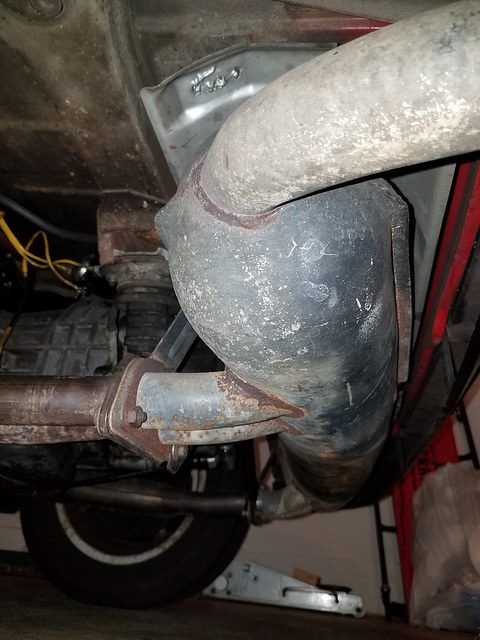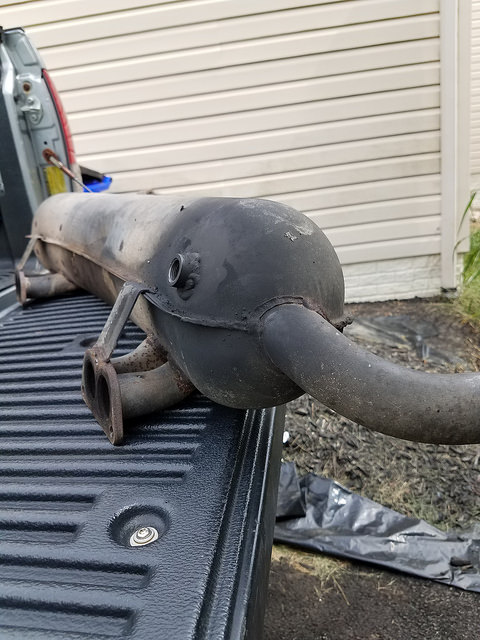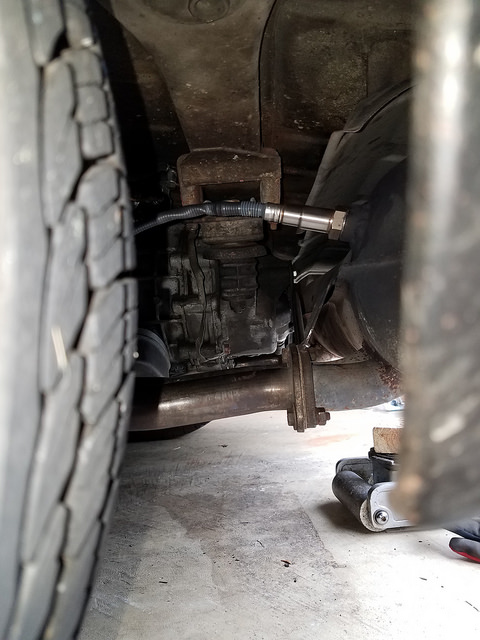Full Version: AFR bung installation stock exhaust
I'll be getting my new AFR in a few days and have the stock 2.0 exhaust Liestriz. There is no 4 to 1 collector like on an extractor muffler. Can someone give me advice where to install the sensor mount? Do I need to cut a hole in the muffler? Thanks.
The optimum is 3 feet and mounted in the 10 or 2 o'clock position.
3ft?
Can you show me visually?
Can you show me visually?
Yes Mark, Splain yourself! 
I think he means, generically, three feet worth of exhaust travel from the exhaust valve. And with the sensor coming up out of the exhaust pipe leaning to the left or right at about a 30-degree angle from horizontal.
On a stock exhaust, I think the closest you can get to that is just aft of the heat exchanger wrapping. It may take a while for the sensor to heat up to the point where it gives a good reading; a heated sensor can help with that.
--DD
On a stock exhaust, I think the closest you can get to that is just aft of the heat exchanger wrapping. It may take a while for the sensor to heat up to the point where it gives a good reading; a heated sensor can help with that.
--DD
I'll be getting my new AFR in a few days and have the stock 2.0 exhaust Liestriz. There is no 4 to 1 collector like on an extractor muffler. Can someone give me advice where to install the sensor mount? Do I need to cut a hole in the muffler? Thanks.
There really isnt a great place to put one with a stock muffler given the muffler is the collector. Your options are as you stated place it in the muffler itself which is not ideal or in the tailpipe which is probably worse.
I ran into the same situation with my 1.7, my solution was to buy a bursch exhaust.
Yes, 3 feet (from engine) is the generic distance, maybe place it in the muffler just above one of the exchanger outlets. I used to say it could be put into the tail pipe, but I was wrong, you run a good chance that the sensor will not heat up enough to give accurate readings. A heated sensor doesn't provide enough heat for an accurate reading, it only speeds up the sensor warm-up cycle.
Never leave a disconnected sensor in the exhaust, it will ruin the sensor.
The 10 or 2 o'clock angle lets any moisture drain from the sensor when not in use. Standing moisture can also ruin a sensor.
Never leave a disconnected sensor in the exhaust, it will ruin the sensor.
The 10 or 2 o'clock angle lets any moisture drain from the sensor when not in use. Standing moisture can also ruin a sensor.
I thought that closer to the head was ideal. but that would mean putting it in the HE before the shrouding for the heater. On my motorcycle it is placed about 4 inches from the exhaust port.
that said, currently the sensor on my car is mounted in the Triad exhaust, probably more than 3 feet from the head. and it is a heated sensor. I have always wondered if the distance from the head could affect the accuracy of the sensor.
that said, currently the sensor on my car is mounted in the Triad exhaust, probably more than 3 feet from the head. and it is a heated sensor. I have always wondered if the distance from the head could affect the accuracy of the sensor.
I placed my sensor (heated) just outside the muffler in the single tail pipe - 914 6 conversion - 911 2.7 Ltr engine with headers. Readings appear to be logical and indicative of engine performance based on amount of tail pipe and spark plug carbon deposit checks, and reactions to carb jet changes. Experts have told me that these after market devices are approximate at best but helpful in tuning engines and monitoring A/F trends in operation.
I used to say it could be put into the tail pipe, but I was wrong, you run a good chance that the sensor will not heat up enough to give accurate readings. A heated sensor doesn't provide enough heat for an accurate reading, it only speeds up the sensor warm-up cycle.
There is no magic distance from the head. In general, hotter is better, until you exceed 1030C (1886F) if you are using a Bosch LSU4.2/LSU4.9 sensor. I believe the NTK sensors go a bit higher but they aren't super common in the hobbyist market. Distance from the head is important to reduce sensor latency (delay time from reading what's actually happening) if you are doing per cycle tuning, but that's an OEM kind of thing.
The heater is capable of keeping the Nernst cell hot enough wherever you put it really. The issue with putting it into a tailpipe is flow reversion pulling fresh air in and causing the sensor to read false lean.
It may take a while for the sensor to heat up to the point where it gives a good reading; a heated sensor can help with that.
Pretty much all sensors/aftermarket controllers these days are heated and use the elements so you don't really have to worry about that.
that said, currently the sensor on my car is mounted in the Triad exhaust, probably more than 3 feet from the head. and it is a heated sensor. I have always wondered if the distance from the head could affect the accuracy of the sensor.
I would get a muffler with collector too and put it there if you can so you can read all cylinders. Otherwise it seems like in any of the HEX pipes like DD said would work OK, just not give you a full picture.
I used to say it could be put into the tail pipe, but I was wrong, you run a good chance that the sensor will not heat up enough to give accurate readings. A heated sensor doesn't provide enough heat for an accurate reading, it only speeds up the sensor warm-up cycle.
There is no magic distance from the head. In general, hotter is better, until you exceed 1030C (1886F) if you are using a Bosch LSU4.2/LSU4.9 sensor. I believe the NTK sensors go a bit higher but they aren't super common in the hobbyist market. Distance from the head is important to reduce sensor latency (delay time from reading what's actually happening) if you are doing per cycle tuning, but that's an OEM kind of thing.
The heater is capable of keeping the Nernst cell hot enough wherever you put it really. The issue with putting it into a tailpipe is flow reversion pulling fresh air in and causing the sensor to read false lean.
It may take a while for the sensor to heat up to the point where it gives a good reading; a heated sensor can help with that.
Pretty much all sensors/aftermarket controllers these days are heated and use the elements so you don't really have to worry about that.
that said, currently the sensor on my car is mounted in the Triad exhaust, probably more than 3 feet from the head. and it is a heated sensor. I have always wondered if the distance from the head could affect the accuracy of the sensor.
I would get a muffler with collector too and put it there if you can so you can read all cylinders. Otherwise it seems like in any of the HEX pipes like DD said would work OK, just not give you a full picture.
I used to think that as well.
Thinking of building and maybe selling my own meters. So I've done a fair bit of research on the 4.9 LSU.
Ok so I'm pretty much F'd, unless I get another exhaust?
Anyone have an exhaust I can barrow? Even better if it already has the bung for the LSU4.9 sensor
@Keith - I think I might place it where you did.
Here is what I'm working with:

Anyone have an exhaust I can barrow? Even better if it already has the bung for the LSU4.9 sensor
@Keith - I think I might place it where you did.
Here is what I'm working with:

Put it like this, as close to in line with the input as you can.
Thanks all!
@Mark - Can I put the bung on the outside pretty much where the tip of your red line is or possible above so it has a 10 degree angle?
Edit - After I typed that I realized that is exactly what your were saying
@Mark - Can I put the bung on the outside pretty much where the tip of your red line is or possible above so it has a 10 degree angle?
Edit - After I typed that I realized that is exactly what your were saying
Yeh...my paint skills are lacking....
In line with the muffler inlet, that's the area likely to have more heat.
If you can weld the bung at say 9 o'clock then I'd try to stick a bar in, heat the surrounding steel cherry red and bend it to 10 o'clock.
In line with the muffler inlet, that's the area likely to have more heat.
If you can weld the bung at say 9 o'clock then I'd try to stick a bar in, heat the surrounding steel cherry red and bend it to 10 o'clock.
Mark I took it by a shop today and the tech marked this place. I'm going to remove the exhaust to have him weld in the bung. How does this placement look? Sorry not sure how to rotate via attachmentClick to view attachment
That looks pretty much about where I've got mine mounted. About 3 years since installation and no apparent problems. Gauge starts reading within a few seconds of starting cold.
That's a great muffler, my favorite.
That looks pretty much about where I've got mine mounted. About 3 years since installation and no apparent problems. Gauge starts reading within a few seconds of starting cold.
Same here, can take a photo and post it tonight if you want. Has been working great for me also.
That looks pretty much about where I've got mine mounted. About 3 years since installation and no apparent problems. Gauge starts reading within a few seconds of starting cold.
Same here, can take a photo and post it tonight if you want. Has been working great for me also.
Falcor75 - definitely post that pic. I dropped the muffler off this morning. Should pick it up this afternoon and install when I get home.
That's good but it might not be quite the 10 or 2 o'clock position, easily adjusted with the heating and bar trick.
Here is the finished product:



Problem with that install is it's closer to a 9 o'clock position, so the sensor may not drain all of the moisture out of the sensor. Heat the surrounding metal cherry red, then taking a bar bend the sheet metal and bung up 30 degrees and closer to the 10 O'clock position.
Umm no, I'm not putting a torch to my Scart muffler.
The sensor is fine, its heated and has been there for 18 months with zero issues.
I think the 10-12 position has more relevance if you mount the sensor in a smaller diameter exhaust pipe, in my case its still 4 inches from the bottom of the "tube" so any moisture trapped in the exhaust will have a hard time reaching the sensor tip.
The sensor is fine, its heated and has been there for 18 months with zero issues.
I think the 10-12 position has more relevance if you mount the sensor in a smaller diameter exhaust pipe, in my case its still 4 inches from the bottom of the "tube" so any moisture trapped in the exhaust will have a hard time reaching the sensor tip.
This is a "lo-fi" version of our main content. To view the full version with more information, formatting and images, please click here.
